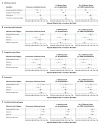National trends in patient safety for four common conditions, 2005-2011
- PMID: 24450892
- PMCID: PMC4042316
- DOI: 10.1056/NEJMsa1300991
National trends in patient safety for four common conditions, 2005-2011
Abstract
Background: Changes in adverse-event rates among Medicare patients with common medical conditions and conditions requiring surgery remain largely unknown.
Methods: We used Medicare Patient Safety Monitoring System data abstracted from medical records on 21 adverse events in patients hospitalized in the United States between 2005 and 2011 for acute myocardial infarction, congestive heart failure, pneumonia, or conditions requiring surgery. We estimated trends in the rate of occurrence of adverse events for which patients were at risk, the proportion of patients with one or more adverse events, and the number of adverse events per 1000 hospitalizations.
Results: The study included 61,523 patients hospitalized for acute myocardial infarction (19%), congestive heart failure (25%), pneumonia (30%), and conditions requiring surgery (27%). From 2005 through 2011, among patients with acute myocardial infarction, the rate of occurrence of adverse events declined from 5.0% to 3.7% (difference, 1.3 percentage points; 95% confidence interval [CI], 0.7 to 1.9), the proportion of patients with one or more adverse events declined from 26.0% to 19.4% (difference, 6.6 percentage points; 95% CI, 3.3 to 10.2), and the number of adverse events per 1000 hospitalizations declined from 401.9 to 262.2 (difference, 139.7; 95% CI, 90.6 to 189.0). Among patients with congestive heart failure, the rate of occurrence of adverse events declined from 3.7% to 2.7% (difference, 1.0 percentage points; 95% CI, 0.5 to 1.4), the proportion of patients with one or more adverse events declined from 17.5% to 14.2% (difference, 3.3 percentage points; 95% CI, 1.0 to 5.5), and the number of adverse events per 1000 hospitalizations declined from 235.2 to 166.9 (difference, 68.3; 95% CI, 39.9 to 96.7). Patients with pneumonia and those with conditions requiring surgery had no significant declines in adverse-event rates.
Conclusions: From 2005 through 2011, adverse-event rates declined substantially among patients hospitalized for acute myocardial infarction or congestive heart failure but not among those hospitalized for pneumonia or conditions requiring surgery. (Funded by the Agency for Healthcare Research and Quality and others.).
Figures


References
-
- Institute of Medicine. To err is human: building a safer health system. Washington, DC: National Academy Press; 2000.
-
- Leape LL, Berwick DM. Five years after To Err Is Human: what have we learned? JAMA. 2005;293:2384–90. - PubMed
-
- Clinton HR, Obama B. Making patient safety the centerpiece of medical liability reform. N Engl J Med. 2006;354:2205–8. - PubMed
-
- Studdert DM, Mello MM, Gawande AA, et al. Claims, errors, and compensation payments in medical malpractice litigation. N Engl J Med. 2006;354:2024–33. - PubMed
-
- Gallagher TH, Studdert D, Levinson W. Disclosing harmful medical errors to patients. N Engl J Med. 2007;356:2713–9. - PubMed
Publication types
MeSH terms
Grants and funding
LinkOut - more resources
Full Text Sources
Other Literature Sources
Medical
